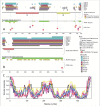The roles of intrinsic disorder-based liquid-liquid phase transitions in the "Dr. Jekyll-Mr. Hyde" behavior of proteins involved in amyotrophic lateral sclerosis and frontotemporal lobar degeneration
- PMID: 28980860
- PMCID: PMC5788550
- DOI: 10.1080/15548627.2017.1384889
The roles of intrinsic disorder-based liquid-liquid phase transitions in the "Dr. Jekyll-Mr. Hyde" behavior of proteins involved in amyotrophic lateral sclerosis and frontotemporal lobar degeneration
Abstract
Pathological developments leading to amyotrophic lateral sclerosis (ALS) and frontotemporal lobar degeneration (FTLD) are associated with misbehavior of several key proteins, such as SOD1 (superoxide dismutase 1), TARDBP/TDP-43, FUS, C9orf72, and dipeptide repeat proteins generated as a result of the translation of the intronic hexanucleotide expansions in the C9orf72 gene, PFN1 (profilin 1), GLE1 (GLE1, RNA export mediator), PURA (purine rich element binding protein A), FLCN (folliculin), RBM45 (RNA binding motif protein 45), SS18L1/CREST, HNRNPA1 (heterogeneous nuclear ribonucleoprotein A1), HNRNPA2B1 (heterogeneous nuclear ribonucleoprotein A2/B1), ATXN2 (ataxin 2), MAPT (microtubule associated protein tau), and TIA1 (TIA1 cytotoxic granule associated RNA binding protein). Although these proteins are structurally and functionally different and have rather different pathological functions, they all possess some levels of intrinsic disorder and are either directly engaged in or are at least related to the physiological liquid-liquid phase transitions (LLPTs) leading to the formation of various proteinaceous membrane-less organelles (PMLOs), both normal and pathological. This review describes the normal and pathological functions of these ALS- and FTLD-related proteins, describes their major structural properties, glances at their intrinsic disorder status, and analyzes the involvement of these proteins in the formation of normal and pathological PMLOs, with the ultimate goal of better understanding the roles of LLPTs and intrinsic disorder in the "Dr. Jekyll-Mr. Hyde" behavior of those proteins.
Keywords: amyotrophic lateral sclerosis; frontotemporal lobar degeneration; intrinsically disordered proteins; liquid-liquid phase transition; neurodegeneration; proteinaceous membrane-less organelles.
Figures








Similar articles
-
Nuclear trafficking in amyotrophic lateral sclerosis and frontotemporal lobar degeneration.Brain. 2017 Jan;140(1):13-26. doi: 10.1093/brain/aww197. Epub 2016 Aug 6. Brain. 2017. PMID: 27497493 Review.
-
Intracellular dynamics of Ataxin-2 in the human brains with normal and frontotemporal lobar degeneration with TDP-43 inclusions.Acta Neuropathol Commun. 2020 Oct 28;8(1):176. doi: 10.1186/s40478-020-01055-9. Acta Neuropathol Commun. 2020. PMID: 33115537 Free PMC article.
-
Mechanisms Associated with TDP-43 Neurotoxicity in ALS/FTLD.Adv Neurobiol. 2018;20:239-263. doi: 10.1007/978-3-319-89689-2_9. Adv Neurobiol. 2018. PMID: 29916022 Review.
-
Unconventional features of C9ORF72 expanded repeat in amyotrophic lateral sclerosis and frontotemporal lobar degeneration.Neurobiol Aging. 2014 Oct;35(10):2421.e1-2421.e12. doi: 10.1016/j.neurobiolaging.2014.04.015. Epub 2014 Apr 19. Neurobiol Aging. 2014. PMID: 24836899 Review.
-
Phase Separation of C9orf72 Dipeptide Repeats Perturbs Stress Granule Dynamics.Mol Cell. 2017 Mar 16;65(6):1044-1055.e5. doi: 10.1016/j.molcel.2017.02.013. Mol Cell. 2017. PMID: 28306503 Free PMC article.
Cited by
-
The dark side of Alzheimer's disease: unstructured biology of proteins from the amyloid cascade signaling pathway.Cell Mol Life Sci. 2020 Oct;77(20):4163-4208. doi: 10.1007/s00018-019-03414-9. Epub 2020 Jan 2. Cell Mol Life Sci. 2020. PMID: 31894361 Free PMC article.
-
A Systematic Review of Suggested Molecular Strata, Biomarkers and Their Tissue Sources in ALS.Front Neurol. 2019 May 14;10:400. doi: 10.3389/fneur.2019.00400. eCollection 2019. Front Neurol. 2019. PMID: 31139131 Free PMC article. Review.
-
Pan-retroviral Nucleocapsid-Mediated Phase Separation Regulates Genomic RNA Positioning and Trafficking.Cell Rep. 2020 Apr 21;31(3):107520. doi: 10.1016/j.celrep.2020.03.084. Cell Rep. 2020. PMID: 32320662 Free PMC article.
-
SERBP1 interacts with PARP1 and is present in PARylation-dependent protein complexes regulating splicing, cell division, and ribosome biogenesis.Elife. 2025 Feb 12;13:RP98152. doi: 10.7554/eLife.98152. Elife. 2025. PMID: 39937575 Free PMC article.
-
Background-deflection Brillouin microscopy reveals altered biomechanics of intracellular stress granules by ALS protein FUS.Commun Biol. 2018 Sep 10;1:139. doi: 10.1038/s42003-018-0148-x. eCollection 2018. Commun Biol. 2018. PMID: 30272018 Free PMC article.
References
-
- Kim HJ, de Leon M, Wang X, Kim HY, Lee YJ, Kim YH, Kim SH. Relationship between clinical parameters and brain structure in sporadic amyotrophic lateral sclerosis patients according to onset type: A voxel-based morphometric study. PLoS One. 2017;12:e0168424. doi: 10.1371/journal.pone.0168424. PMID:28095425. - DOI - PMC - PubMed
Publication types
MeSH terms
Substances
LinkOut - more resources
Full Text Sources
Other Literature Sources
Medical
Miscellaneous
